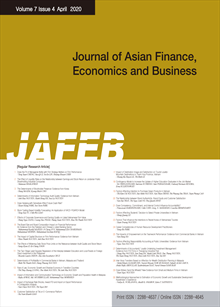간행물
The Journal of Asian Finance, Economics and Business KCI 등재 SCOPUS

- 발행기관 한국유통과학회
- 자료유형 학술지
- 간기 계간
- ISSN 2288-4637 (Print)2288-4645 (Online)
- 수록기간 2014 ~ 2020
- 주제분류 사회과학 > 경영학 사회과학 분류의 다른 간행물
- 십진분류KDC 325DDC 330
권호리스트/논문검색
제1권 제2호 (2014년 5월) 4건
1.
2014.05
서비스 종료(열람 제한)
The purpose of this paper is to carry out an empirical analysis of the link that exists between microfinance and poverty alleviation. The analysis is driven by literature searches on empirical works done by different researchers in different contexts. Qualitative research methodology was adopted, following a desktop approach. An empirical literature review took a centre stage in this investigation. An analysis of empirical works shows that microfinance enhances poverty alleviation despite the challenges such as the Indian Andhra Pradesh crisis. The paper is limited to a review of empirical sources of literature. A field survey, supported by an econometric analysis would have helped to generate robust results. This paper attempts to bring together the empirical works that were done in different contexts to shed light on the important relationship between microfinance and poverty. Many research works on microfinance depend upon personal anecdotes, thus this present paper attempts to compile the scattered empirical findings on microfinance and poverty alleviation.
2.
2014.05
서비스 종료(열람 제한)
Priorities, Mechanisms and Prospects on Industrial Clusters and Special Economic Zones in Kazakhstan
This research investigates the characteristics, principles, advantages, factors and problems of cluster development in Kazakhstan, and identifies the prerequisites, conditions and stages of organizing clusters on the framework of special economic zones. In this research, we used methods, which will allow analyzing of the organization industrial clusters in special economic zones in Kazakhstan. The author studied international experience of cluster development and the efficiency of the use of the model of the "rhombus effect" with account the specific features of interaction between the participants of the cluster, analysis of the legal framework for the formation and development of clusters. These have been identified as the more important or strategically necessary clusters in Kazakhstan: innovation- technological cluster, innovation-education cluster, innovation- petrochemical cluster, innovative-metallurgical cluster, transport and logistics cluster, textile industry cluster, tourism cluster, agro cluster, construction cluster, medical and pharmaceutical cluster. Firstly, the results suggest that the interaction of science, education, business and government in the development and implementation of innovation policy is not sufficiently structured to provide a balanced representation of the interests of the range of various innovative enterprises in Kazakhstan. Secondly, the legal basis of cluster development in Kazakhstan is determined. Need to develop mechanisms for the implementation of promising direction. Thirdly, the clusters can be formed in the existing special economic zones, allowing them to get right to the mass production of high-tech products that are developed.
3.
2014.05
서비스 종료(열람 제한)
The small number of fusion research that addresses fear-appeal and self-efficacy in the effectiveness of warning labels cause the label is not clear, then the purpose of the study is the first to examine the effect of the combination of the message. With the experimental method, a total of 240 participants were smokers consist of Indonesian university students in the age range 18-23 years. Data obtained then processed with ANOVA statistical methods and Test T. The results are consistent with previous studies that the visual warning labels more effective than the textual warning labels alone. Results also suggest that a warning label should be both visual and textual messages combined with self-efficacy. Limitations, this study does not differentiate among smokers and non-smokers, in addition to the images are used only one type of disease, so that the research needs to be done to distinguish these factors.
4.
2014.05
서비스 종료(열람 제한)
The portfolio selection is one of the most important and vital decisions that a real or legal person, who invests in stock market, should make. The main purpose of this article is the determination of the optimal portfolio with regard to relations among stock returns of companies which are active in Tehran’s stock market. For achieving this goal, weekly statistics of company’s stocks since Farvardin 1389 until Esfand 1390, has been used. For analyzing statistics and information and examination of stocks of companies which has change in returns, factors analysis approach and clustering analysis has been used (FC approach). With using multivariate analysis and with the aim of reducing the unsystematic risk, a financial portfoliois formed. At last but not least, results of choosing the optimal portfolio rather than randomly choosing a portfolio are given.

